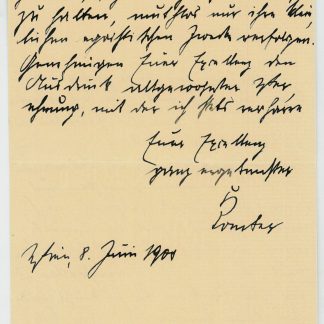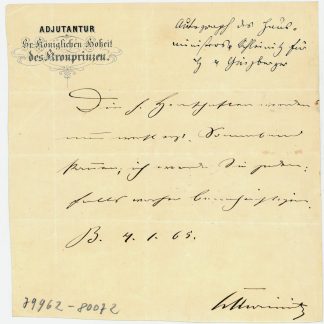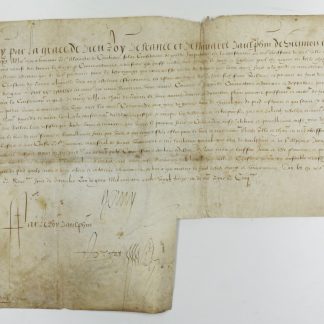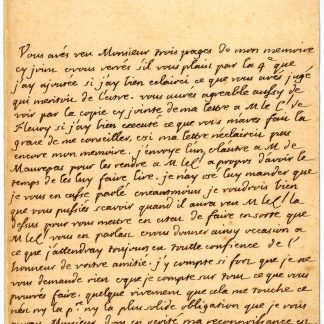Fighting a losing battle for his "dignité": Saint-Simon's 1728 intercession with Cardinal Fleury
Autograph letter signed ("Le Duc de Saint Simon").
4to. 1 p. on bifolium.
€ 6,500.00
Interesting letter to Germain-Louis Chauvelin (1685-1762), garde des sceaux and foreign minister to Louis XV at the time of writing, concerning an intervention with Cardinal André-Hercule de Fleury (1653-1743), first minister to the King, in a question of precedence among the dukes and pairs of France within the Ordre du Saint-Esprit. Saint-Simon had written a memorandum arguing that he and the Duc de Richelieu should take precedence over marshal Claude Louis Hector de Villars (1653-1734) in the next promotion of the royal order. Apparently, he had previously sent a draft of the memorandum to Chauvelin, which he revised, based on the feedback. Originally attached to the letter at hand were the final version of the memorandum and the copy of a letter to Fleury. The original of this letter was to be forwarded to the minister together with another copy of the memorandum via the secretary of state Jean Frédéric Phélypeaux, Count of Maurepas. Imbuing the affair with an air of intrigue, Saint-Simon asks Chauvelin, in the name of their friendship, to report back to him whatever Fleury, who was not supposed to know that Chauvelin was in contact with Saint-Simon in this matter, would say about his letter and the memorandum. In his letter, Saint-Simon asks Fleury to present his case to King Louis XV and promises to accept any decision with complete discretion.
Both the letter to Fleury, likewise dated 10 January 1728, and the memorandum are published. Questions of precedence as well as the rights and prerogatives of the dukes and pairs of France are central to Saint-Simon's thinking and acting, forming a recurrent theme of his life and, consequently, his famous Mémoires. We do not know whether Saint-Simon was successful in his request, but Fleury would have been an unexpected ally and Villars a powerful adversary. Saint-Simon despised Fleury, as the cardinal-ministers, especially since Jules Mazarin, represented to him the rise of the noblesse de robe as opposed to the old aristocracy, and foreign (papal) influence. He particularly reproached Fleury for his role in the 1707 invasion of the Provence by Victor Amadeus II during the War of Spanish Succession. Then Bishop of Fréjus, Fleury avoided the passage of Savoyard troops through his diocese by direct negotiations with Victor Amadeus, even welcoming the Duke in Fréjus, which incited suspicion of treason in Versailles. And while Saint-Simon withdrew from Versailles following the death of the Regent Philippe II in 1723, the Duke de Villars stood high in the King's favour. Saint-Simon's complete resignation and disillusionment following the end of the regency and his exit as a courtier were summed up in a famous letter to Fleury written just three months after the letter at hand. At this point, he had to defend himself following the unauthorized publication of a memorandum from 1722 concerning the loss of ducal prerogatives since the beginning of the regency. Saint-Simon wrote: "Vous me serez témoin que je ne vous ai guère en ma vie importuné des déconvenues de notre Dignité. Je la tiens éteinte, et moi en particulier pour mort" ("You are my witness that I have never bothered you about the disappointments to our dignity. I consider it extinguished, and myself, in particular, dead").
Together with a fine engraved portrait of Saint-Simon by Louis-François Mariage (fl. 1785-1828), based on the famous 1728 portrait by Jean-Baptiste van Loo, and a clipping of a papered seal.
Minor foxing.
Écrits inédits de Saint-Simon. 4. Mélanges. 3. Lettres, 1705-1742 (Paris: Hachette 1882), pp. 158-167.








